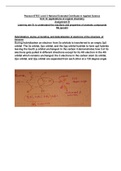Essay
BTEC Applied Science: Unit 14 (Learning Aim B)
- Institution
- PEARSON (PEARSON)
B.P1 B.P2 B.M2 B. D2 Criteria's Met. Learning Aim B: (Distinction - Analyse the effects of Monosubstituents on the benzene ring to predict further substitution position(s) of a reaction species on the benzene ring. This assignment will Gaurantee you a Distinction Achieved Distinction first time....
[Show more]











